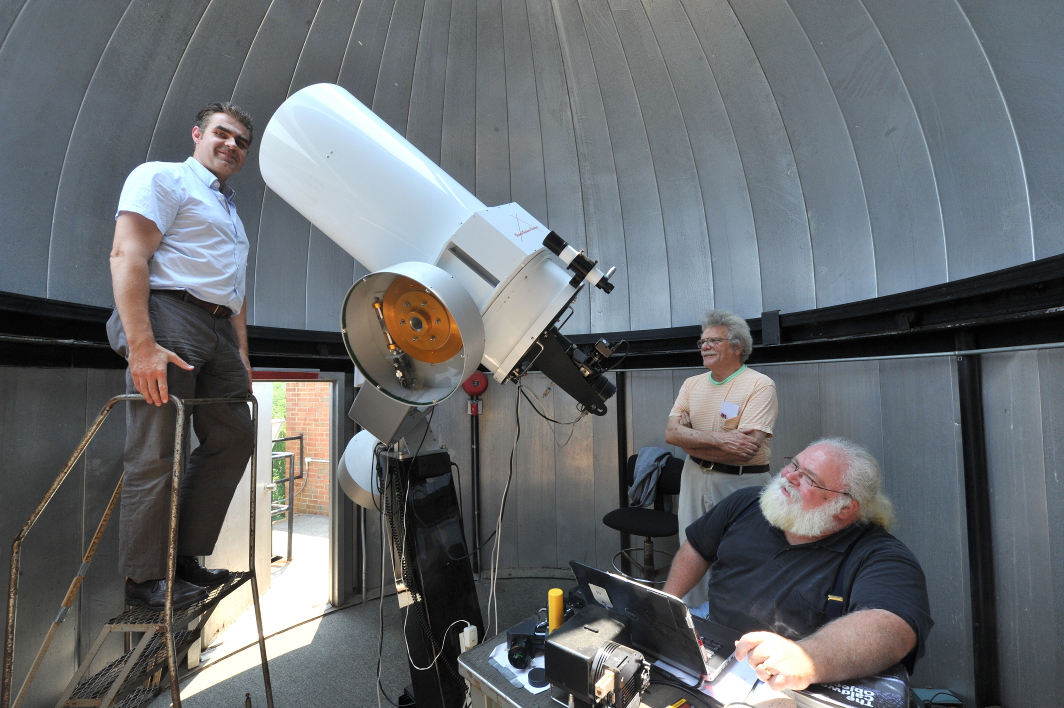
For potential new students! I have openings for possible research projects in the following areas:
- A Physics Prof Bet Me $10,000 I’m Wrong: watch this video describing a sailcar that sails faster than the wind that’s pushing it and build the demonstration described using a 3D printer. Help me demonstrate it to an intro physics class. Then, work with me to think of another, similarly counter-intuitive STEM concept of your choice, create a one-minute video explaining it, and send in an entry to the $10,000 competition described at the end of the video!
- Help build a scientific instrument and launch it into space! Every summer, NASA holds a one-week program called RockOn for undergraduate students at the Wallops Flight Facility in Maryland, 3 hours’ drive from Towson. The requirements are U.S. citizenship (or permanent residence), some knowledge of the Arduino programming language, and an ability to solder. The schools are usually held in June. Interested students should talk with me before December so that I can apply for financial support to cover their costs before the following year’s application deadline.
- Assess the tangible benefits of field trips in physics. In recent years I have begun integrating field trip component into my PHYS 352 course (Thermodynamics and Statistical Physics) classes to visit working steam trains or steamships. But is the added value that students derive from such activities worth the loss of instructional time? I would like to find out! This project would be perfect for a student with a background in science education (possibly even a science education major) who will participate in the field trip, interview students before and after, and analyze their responses as well as their success in the course.
- Measure the fundamental constants of nature. I have worked with three students (Jon Perry, Calin Reamy and Carmen Cuestas) to measure the speed of light using a laser and beam-splitter, and made some progress under COVID conditions with a fourth (Sean Garnett) in an ongoing effort to measure Newton’s gravitational constant G and Coulomb’s constant k (or equivalently the electric permittivity of free space ε0) using torsion balances. This would be an ideal summer project for somebody who has passed PHYS 242 (Introductory electromagnetism), is interested in fundamental physics, and good at careful, patient experimental work.
- Improve truck mileage through aerodynamics. This one comes from our physics teacher-in-residence, Jim Selway, who wondered why trucks all have rectangular shapes. Surely we would burn a lot less fuel if we could make them rounder at the back. This might be accomplished with light, cheap, removeable “caps” – perhaps inflatable ones. It turns out we have a wind tunnel in the basement of Smith Hall, that has not been used in over ten years! The project would involve constructing and testing small-scale models with this wind tunnel, then extrapolating theoretically to estimate the possible savings in fuel efficiency in real life. It would also be perfect for a student with good practical skills.
- Test whether axion quark nuggets (AQNs) are responsible for the galactic UV excess. Together with previous student Josh Tyler and colleagues in India and at Johns Hopkins University, I have reported the existence of a galactic UV background excess beyond that associated with dust-reflected starlight. Ariel Zhitnitsky, a theoretical particle physicist/cosmologist in British Columbia, has proposed that this excess might be caused by dark matter in the form of Axion Quark Nuggets (AQNs), remnants of a phase transition in the early universe. The project is to investigate this possibility using the methods described in my textbook The Light/Dark Universe (World Scientific, 2008). This could suit a student who has taken at least one astronomy course plus PHYS 307 (Mathematical Physics), has an interest in cosmology and particle physics, is willing to read and learn the needed background material, and is comfortable with (or willing to learn) Mathematica and LaTeX.
- Detect the cosmic microwave background radiation. There is a widespread “physics urban legend” that 1% of the static on an old-style television screen is caused by cosmic microwave background from the big bang. I have not been able to find the source of this figure, and the first part of the project will be to see if we can reproduce it or correct it theoretically using approximations. The second part will be to try and measure it! Apparently this can be done using an ordinary satellite dish. This will be a challenging project for a student with strong experimental skills who has taken, or plans to take ASTR 432 (Galaxies and Cosmology) and/or PHYS 411 (General Relativity and Cosmology).
- Study the gravito-electromagnetic analogy to general relativity. As long as speeds are not too high and gravity is not too strong, the equations of general relativity reduce to a set of four equations that are virtually identical to Maxwell’s equations for the electromagnetic field. These equations describe a gravito-electric field (with units of acceleration) and a gravito-magnetic field (with units of angular velocity). Instead of electric charge and current, the sources are mass and “mass current”. If these equations are valid, there must be gravitational analogs of phenomena like Ampere’s and Faraday’s laws (e.g. a gravito-magnetic field should appear inside a coil carrying a sufficiently large “mass current”). Are such phenomena realized in nature? The project is to derive the equations and then attach physically plausible numbers to them to see what they might mean in practice. It would suit a student who has or will soon take PHYS 411 (General Relativity).
If you are interested in pursuing any of these opportunities, or if you have some other project idea that you’d like to discuss, feel free to contact me directly.